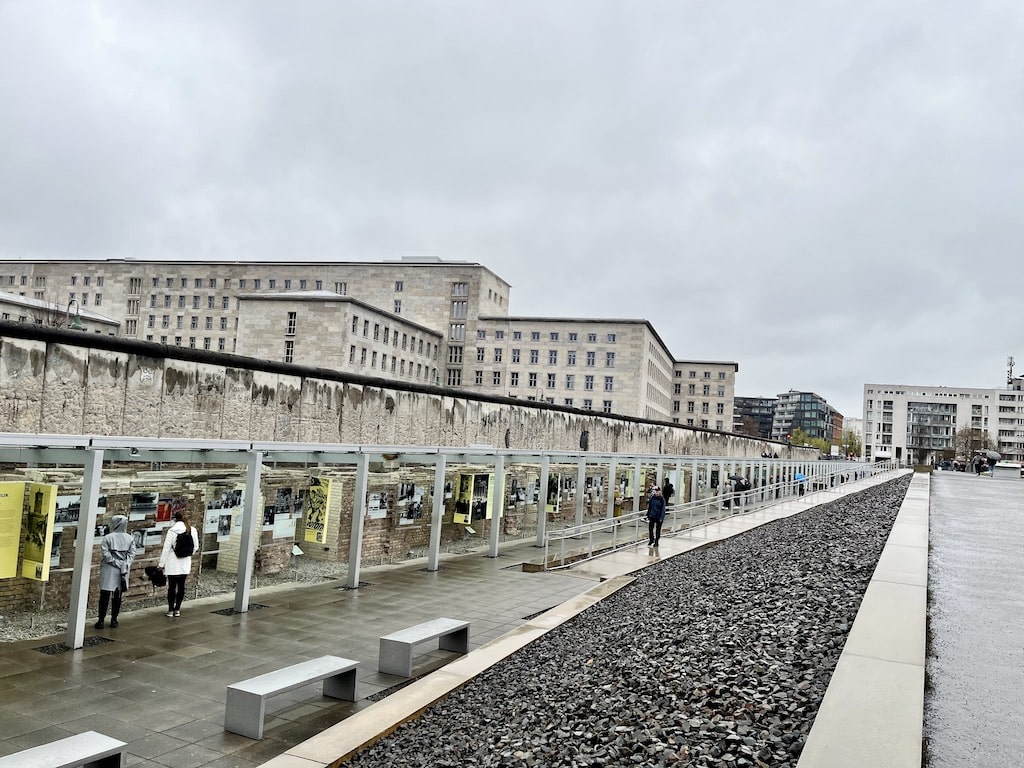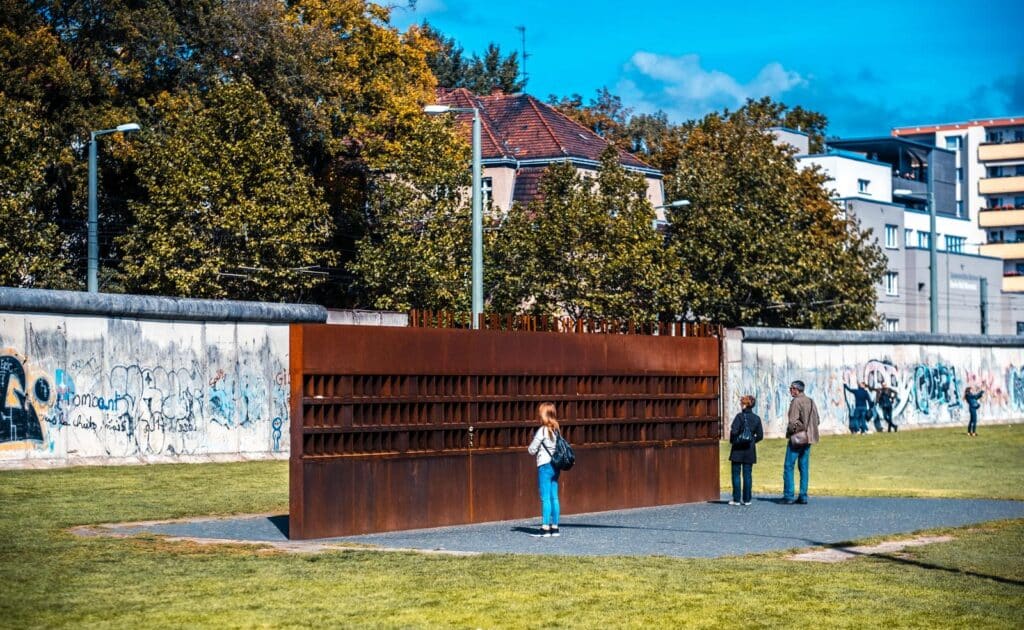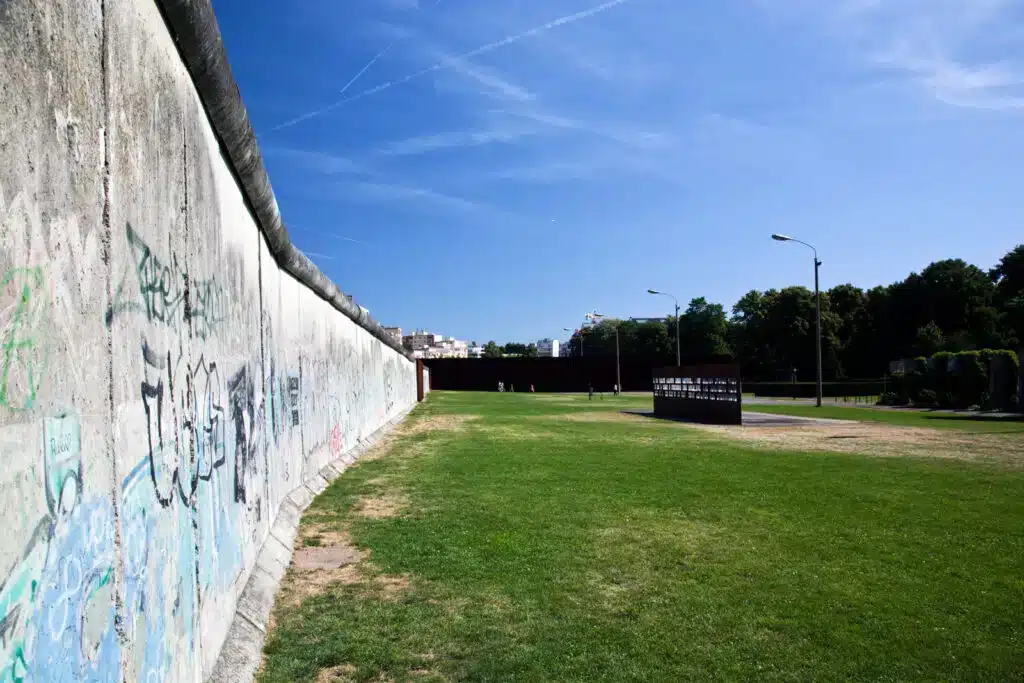Today, most people associate the fall of the Berlin Wall in 1989 with the end of the Cold War. The over 45-kilometre-long “Iron Curtain” had since 1961 divided East and West Germany to prevent emigration from East to West.
Planning a last minute trip to Berlin? 🇩🇪
Here are my favourite places to stay & things to do in German capital.
🛌 Places to Stay:
1. Hotel Adlon Kempinski (luxury hotel where all the celebs are staying too, right by the Brandenburg Gate)
2. NH Collection Mitte (very good hotel with an even better location in the heart of Berlin)
3. H4 Hotel Alexanderplatz (affordable hotel near Alexanderplatz and my favourite area, Prenzlauer Berg)
🎟️ Top Activities & Tours:
1. Fast-track ticket to the TV Tower (skip the slow-moving queue)
2. Go on Boat Tour on the River Spree (lovely way to see a lot of sights)
3. Take a Third Reich and Cold War Walking Tour
4. Take a guided tour to the Sachsenhausen Concentration Camp Memorial
🚇 Get The Berlin WelcomeCard for easy access to public transport (it's also valid on the Airport Express train) & huge discounts on a lot of activities in Berlin.
In short, it was the communists’ attempt to keep their citizens on their own side of the field for economic reasons.
The enormous Wall that divided Germany in two equally divided Europe, so the communist citizens were kept on their own side – without the possibility of escaping to the West.

Many thousands are said to have tried to escape over the Wall during the Berlin Wall’s time, but only a limited number managed to get from east to West without being shot or detained.
On the West side, help was ready, and over 100,000 East Berliners are believed to have fled to some extent. For some, it has been possible to come to a better life – or back to their family – on the other side, while for others, it has ended with capture or death.
In this article, you get answers to all common questions about the Berlin Wall and its fall and I’ll share where it can be seen today.
When was the Berlin Wall built?

The roots of the Berlin Wall date back to August 13, 1961, when the border between East and West Germany was marked with barbed wire and concrete blocks.
The work was carried out by East German workers closely guarded by East German soldiers.
At first, the Wall consisted of a low barbed wire fence, which was expanded to 3 layers of barbed wire fence of 2 meters height on the border, 20 meters inside the border, and 135 meters inside the border.
Later, more and more of the barbed wire fence was replaced with an actual concrete wall, and only in 1965 was the final Berlin Wall completed, which – along with 155 km of other walls around West Berlin and an inner wall against East Berlin – was part of the communists’ separation from USA and the West.
Check out my video from Berlin where the Wall is included too:
Why was the Berlin Wall built?
The Berlin Wall was officially built to shield the GDR (East Germany) from the anti-fascists from the West. In reality, it was probably a panic solution to hold onto its own citizens.
It was indeed a pronounced problem that especially young and well-educated East Germans fled to the West, which was noticeable in the East German economy.
It is estimated that more than 2.7 million people managed to flee from East Germany to West Germany from 1949 until the construction of the Wall in 1961.
The mass exodus later became known as the “East Germans’ vote with their feet“. It was obvious that the East Germans were dissatisfied with the communist conditions.
To avoid a ruined East Germany, the Berlin Wall was erected to trap its own citizens inside and force them to remain part of the communist GDR.
Outwardly, however, it was a shield against the anti-fascism of the West.
This documentary about the Stasi and the Berlin Wall is extremely interesting and I highly recommend it:
How long was the Berlin Wall?
What is known today as the Berlin Wall is the Wall that ran through the centre of Berlin.
The Wall was 45.1 km long but only formed part of the total border crossings, consisting of walls and barbed wire totalling approximately 155 km around West Berlin.
In addition to the concrete Wall and barbed wire, the border between East and West Berlin also consisted of guard towers, bunkers, fences, tank traps, border roads, minefields, self-shooting facilities and dogs – and the Hinderlandmauer, which was the hinterland wall against East Berlin, located between 50 and 100 meters from the Berlin Wall.
Spread across the entire border, there were 8 border crossings where it was possible to cross from West to east.
Only in a few cases was it possible to travel from east to West; this applied, for example, to high-ranking representatives of the GDR.

The most famous of the border crossings is known today as Checkpoint Charlie and is one of the significant Berlin attractions of today.
See my guide on the best things to do in Berlin for more suggestions.
When did the Berlin Wall fall?

The Berlin Wall officially fell on November 9, 1989.
But even though this date is etched into Germany’s history, it all started in Hungary in May of the same year, where Hungarian rebels began tearing down the border fence with Austria.
Later in the summer, the somewhat more free Hungarians had the idea to hold a peace demonstration in the form of a border picnic, and they negotiated 3 hours of open borders on August 19, 1989, for the purpose.
Here, Hungarians, Austrians, and Germans grilled and sang in peace and harmony.
Therefore, it is also said that the Hungarians removed the first stone from the Berlin Wall.
The fall of the Wall as a result of erroneous press conference
The fall of the Berlin Wall was triggered after a press conference with Günter Schabowski, a member of the Politburo. Here, more or less free exit is suggested. The East Berliners immediately took it to heart and turned up en masse at the Wall to be let through.
However, it turned out that the new law had yet to be finally passed, and the border guards needed to be informed.
However, the masses’ demands meant that East Berliners were initially let over the borders by showing a passport and having it stamped during the evening of November 9, 1989.
Later in the evening – just before midnight – the first East Berliners were let through the borders without any kind of control.
The day after – on November 10, 1989 – when there was now no doubt about the fall of the Wall, the masses streamed in thousands to cross the border that had been completely closed for years.
In West Berlin, there was a popular festival. East Berliners were welcomed with open arms, and there were free serving many places to celebrate the reunification.
In the time after, the Wall was largely torn down by the people as a symbolic act. Therefore, there is little left of the Berlin Wall today.
Also, read all about the TV Tower in Berlin.
What did the Berlin Wall look like?
It was covered with graffiti in all shapes and colours on the West Berlin side of the Wall. This side of the Wall is a fine expression of how the West’s view of the Wall was.
On the east side, few saw the Wall with their own eyes, as a high inner wall – Hinderlandmauer – was built between 50 and 100 meters inside East Berlin. It was only this Wall that most East Berliners actually saw.
The area between Hinderlandmauer and the Berlin Wall was illegal to invade, and the area consisted of barbed wire, lighting, traps, and mines; just like it was allowed for the border guards to shoot unwanted people who stayed between the walls.
Where can you see the Berlin Wall today?

Today, there is little of the Berlin Wall left. Especially as a result of Berlin’s internal renovations and expansions, it is very limited where the Wall can be seen.
However, there is a double row of cobblestones through the city where the Wall once stood.
There are a few clips with the wall in my Berlin video here:
If you want to know about the Berlin Wall, consider going on a guided tour:
There is only about 1.5 km of the original Wall left in total. 1.3 km of the Wall is a collective part called East Side Gallery.
East Side Gallery is today an official and preservation-worthy memorial, and it is located at these addresses: Mühlenstraße 3-100, 14059 Berlin.
Read about public transport in Berlin here.
The remaining 200 meters of the Wall are divided into smaller pieces.
If you want to see the Berlin Wall, East Side Gallery or Gedenkstätte Berliner Mauer in Prenzlauer Berg are the places to visit.
However, there is also a small piece if you walk from Checkpoint Charlie to Topographie des Terrors.

If you want to stay close to the Berlin Wall on your Berlin trip, choose a hotel in Friedrichshain or Prenzlauer Berg.
Check out my guide to the best areas and where to stay in Berlin.
If you have any questions about the Berlin Wall or your Berlin trip, please comment below.
Frequently Asked Questions about the Berlin Wall:
Why was the Wall built?
The Wall was built by the East German government in 1961 to prevent people from East Germany from fleeing to West Germany.
Is there still anything left of the Wall today?
Yes, there is still something left of the Berlin Wall today. Several sections of the Wall have been preserved as memorials and tourist attractions in Berlin. The most famous part of the Wall is the East Side Gallery, a 1.3 km long section located along the Spree River in the Friedrichshain-Kreuzberg district.
In addition, memorials and museums are scattered throughout the city that remind us of the Wall’s history and its impact on life in Berlin during the Cold War.
How long was the Berlin Wall?
The Berlin Wall was around 155 kilometres (96 miles) long. It was not a continuous wall but a barrier consisting of walls, barbed wire, and watchtowers.
Were there any successful escape attempts over the Wall?
Yes, there were several successful escape attempts over the Berlin Wall. Even though crossing the Wall was very dangerous and often deadly, many people managed to escape to West Germany during the 28 years the Wall stood up. Some famous escape attempts include tunnel actions, balloon flights, and even a homemade mini-submarine. Unfortunately, many people were also killed or injured in their attempts to escape over the Wall.
Who ordered the construction of the Berlin Wall?
The construction of the Berlin Wall was ordered by Walter Ulbricht, the leader of the Socialist Unity Party and the state council chairman of the German Democratic Republic (East Germany). It was built on August 13, 1961, to protect its population from fascist elements conspiring to prevent the people’s will in building a socialist state in East Germany. In reality, it was a measure to prevent mass defections from East to West.
How and when did the Berlin Wall fall?
The Berlin Wall fell on November 9, 1989. A series of peaceful political protests and diplomatic pressure throughout that year, notably the peaceful revolution of East Germany, led to the announcement by the East German government that all GDR citizens could visit West Germany and West Berlin. Miscommunication about the timing of this announcement led to masses of East Germans gathering at the Wall, and the overwhelmed border guards eventually opened the gates. This momentous event marked the end of the Wall and the beginning of the end for the Cold War.
What was Checkpoint Charlie?
Checkpoint Charlie was the best-known border crossing between East and West Berlin during the Cold War. It became an iconic symbol of the Cold War, representing the separation of East and West. Today, it’s a must-visit site for history enthusiasts where a replica of the famous guard house and sign that once marked the border crossing stand.
What happened to the Berlin Wall after it fell?
Almost all of it was quickly removed after the fall of the Berlin Wall. Pieces were chipped away by Germans and tourists, becoming sought-after souvenirs known as Mauerspechte or ‘wall woodpeckers’. Larger sections were removed by the government for historical preservation or sold in auctions worldwide. Today, only a few sections of the Wall remain preserved as historical monuments.
How does Berlin remember the Wall today?
Berlin remembers the Wall through several poignant memorials and exhibitions. The East Side Gallery showcases a stretch of the Wall adorned with murals painted by artists from around the world.
The Berlin Wall Memorial and Documentation Centre offer insight into the historical context of the Wall. In many parts of the city, a line of cobblestones marks where the Wall once stood, a subtle yet ever-present reminder of the city’s divided past.
What role did the Berlin Wall play during the Cold War?
The Berlin Wall physically manifested the ideological divide between the East and West during the Cold War. It became a symbol of the ‘Iron Curtain’ that separated Western Europe and the Eastern Bloc. It was at the heart of many significant Cold War events and stood as a stark reminder of the political tensions of that period. Its fall was seen globally as the beginning of the end of the Cold War.
Travel ressources & websites I use all the time 👇
• Booking.com has the best offers on hotels and unique places to stay
• GetYourGuide is the best place to book tours & activities with free cancellation
• NordVPN is the only VPN I've ever needed for travel (it just works, everywhere)
• Welcome Pickups is the best & safest place to pre-book airport transfers
Psst 👀 Have you subscribed to my Youtube channel and my Instagram where I provide more useful travel tips?

